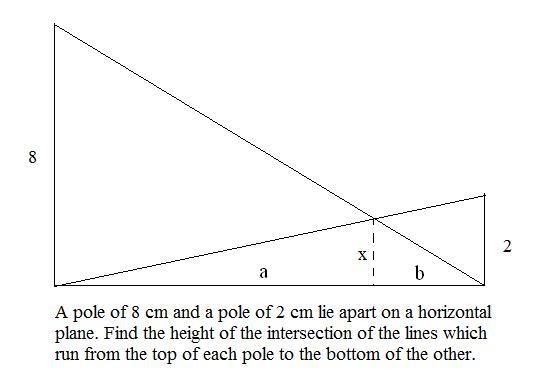Math Is Fun Forum
You are not logged in.
- Topics: Active | Unanswered
Pages: 1
#1 2007-05-24 23:58:42
- Identity
- Member

- Registered: 2007-04-18
- Posts: 934
Similarity q.
This was the final question on the test which we had on similarity and congruency. Baaah! It was worth 5 marks, and I couldn't do it, and the test was out of 30! ![]() I must say the questions on the test were much harder than I anticipated, but oh well, the harder the problems the more I learn I suppose!
I must say the questions on the test were much harder than I anticipated, but oh well, the harder the problems the more I learn I suppose!
Here 'tis (the diagram was not drawn on the paper):
thanks again
Last edited by Identity (2007-05-24 23:59:24)
Offline
#2 2007-05-25 00:53:34
- JaneFairfax
- Member

- Registered: 2007-02-23
- Posts: 6,868
Re: Similarity q.

So the answer to the question is 1.6 cm.
BTW I entitled the image Poles Apart. ![]()
Last edited by JaneFairfax (2007-05-25 00:58:34)
Offline
#3 2007-05-26 17:22:10
- Identity
- Member

- Registered: 2007-04-18
- Posts: 934
Re: Similarity q.
![]() I always have a tendency to understimate the value of abstracting what you see as geometry into algebraic equations. What I found interesting is that although you have 3 variables and 2 equations, you eventually come out with a numerical answer for x. Is that the case often?
I always have a tendency to understimate the value of abstracting what you see as geometry into algebraic equations. What I found interesting is that although you have 3 variables and 2 equations, you eventually come out with a numerical answer for x. Is that the case often?
Offline
#4 2007-05-26 18:12:24
- JaneFairfax
- Member

- Registered: 2007-02-23
- Posts: 6,868
Re: Similarity q.
In this particular case, x happens not to depend on the distance between the two poles. You can move the poles closer to or further away from each other, and the point of intersection of the two diagonal lines will always be the same constant height above the ground.
I think Ive seen a question similar to this before in some problem on optics. You are given a system of lenses or mirrors and a light source, and you are supposed to show that the height of the image is independent of the relative distance between the light source and the lens/mirror system.
Offline
Pages: 1